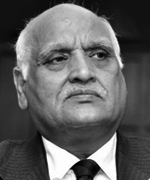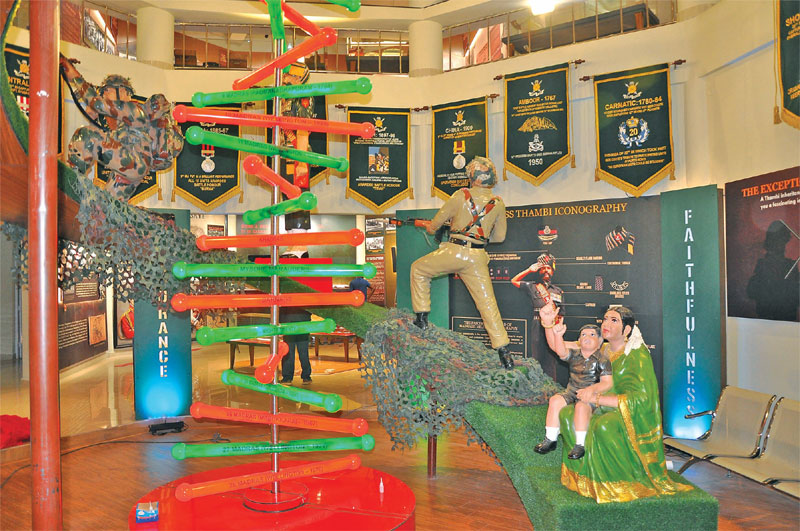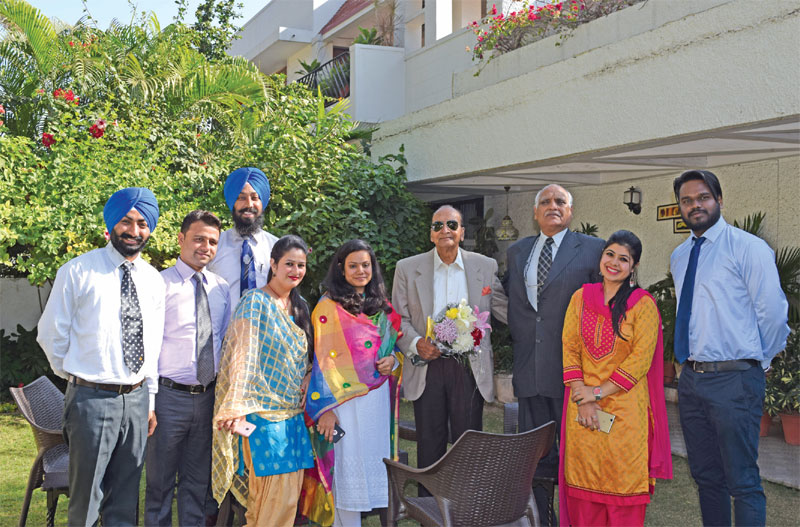It’s a shame that the 1.3 million strong Indian armed forces have only 250-odd museums
 Maj. Gen. Raj Mehta
Maj. Gen. Raj Mehta
The most effective way to destroy people is to deny and obliterate their own understanding of their history
—George Orwell
The English word museum comes from the Greek mouseion, denoting a place or temple dedicated to the Muses; hence a building set apart for study and the arts, philosophy and research at Alexandria, a then Greco-Roman city with the first museum coming up in the early 3rd century BCE. In those ancient times ‘museum’ became a synonym for education. Even the fabled and perceptive Queen Cleopatra was known to have attended museum/temple proceedings at Alexandria.
The purpose of museums today is to protect and conserve artifacts that represent various facets of human history, for the sake of knowledge, understanding and enjoyment. Museums enable people to explore collections for inspiration, learning, and enjoyment. They are institutions that collect, safeguard, and make accessible artifacts, records, cataclysmic events and specimens which they hold in trust, for society.
There are different types of museums all over the world, such as fine arts, applied arts, craft, archaeology, anthropology and ethnology, history, cultural history, military history, science, technology, children’s museums, natural history, numismatics, botanical and zoological gardens and philately. Many are famous landmarks, including the Louvre, in Paris, the British Museum in London; the 19 museums of the Smithsonian Institution, USA and many others.

Public Museums
Though latter-day museums began as private collections displayed in Europe in ‘wonder rooms’ or ‘cabinets of curiosities’ they remained accessible to just the privileged. It was in the Age of Enlightenment beginning with the close of the Thirty Years’ War (1648) and ending with the French Revolution (1789) that the first public museums began flourishing. Thus, the Museo Sacro opened to public in Rome in 1756, the British Museum in London in 1759, the Uffizi Gallery in Florence in 1765 and the Belvedere Palace of the Habsburg monarchs in Vienna opened in 1781.
The first truly public museum was however the Louvre in Paris, opening in 1793 during the French Revolution, enabling for the first time in history free access to the former French royal collections for people of all stations and status. Napoleon Bonaparte conquered the great cities of Europe, confiscating art objects as he went. Napoleon’s concept of a museum as an agent of nationalistic fervor, had a profound influence throughout Europe, which has now spread globally.
India on the Global Museum Map
Turning to India, even as our royalty must had kept their equivalents of European wonder rooms/ cabinets of curiosities for centuries, the first museum originally called the Imperial Museum of Calcutta came about in 1814 through Danish founder-curator Nathanial Wallich. It is India’s oldest (ninth oldest in the world) and largest museum with collections of antiques, body armour, ornaments, fossils, skeletons, mummies and Mughal paintings.
Today, as per the National Portal of Museums run by India’s Ministry of Culture, there are nearly 1,000 museums in India. These include museums under the Central Government, State governments, District level Museums, Museums under universities as well as many private museums. There is no clarity whether the list includes India’s military museums but even if those were to be added, they would not amount to more than 200/250. Inadequate for the world’s third largest regular armed forces, numbering almost 1.3 million men and women.
Military Museums
No statistics are available in the public space but on the basis of nearly four decades of military service and an ongoing fascination with military history thereof, one can share that as of date, we have a very impressive recently developed National War Memorial in Delhi that honours our brave-hearts since Independence. A national war museum is still a work in progress. The good news is that quality construction is under way, away from media glare.
So far as military museums are concerned, each Army Regiment of combat arms, supporting arms and all services, have their museums (often just one; sometimes two) at their Regimental Centres. Not enough is however known about the Navy and Air Force, except that they each have a few centralised museums. Key training establishments in the three Services have in general, a museum to project that training establishment or co-serve as its Regimental Museum. Museums that project women military personnel, families of defence personnel and how defence ‘brats’ are shaped—are of course future areas of development.
Individual units don’t have their museums in the main, making do with ‘Motivation Halls’ or ad hoc ‘museum’ efforts under limited Unit funding. Clearly, so much more needs to be done for the military and of the highest quality and class.
The statistics from 2021 reveal that USA has 33,082 museums, western Europe/ Canada 30,678, adding up to 60 per cent of the world’s museums, Asia Pacific has 18,180, Eastern Europe 11,366 and Israel which is smaller than Mumbai, has 226 museums. In the same context, city-wise statistics have Paris which leads the world with 297 museums, Moscow 261, Los Angeles 219 and national capital Delhi a paltry 30 museums. Overall, India has less than 1 percent of the world’s 1,05,246 museums.
Reform Has Started
Fortunately for India, this isn’t the full story and in recent years there has been a welcome upsurge even if miniscule by world standards. In a first-of-its-kind initiative, Sahapedia, an encyclopaedic tool, aims to map our 1,000 odd museums with results accessible at MuseumsofIndia.org, a museum mapping resource. The site became live on May 18, which is International Museum Day, in 2017 and provides access, conduct and content as well as administrative details.
It is also known that a number of tribal museums are coming up in India’s tribal areas. Military museums need an impetus though, the last public commemoration of a museum being the Rezang La upgrade of memorial to museum at Chushul above which the famous Kumaoni last stand of ‘C’ Company 13 Kumaon and other bravehearts astride the Spanggur Gap, Chushul, sacrificed themselves for Naam, Namak, Nishan… Honour, Integrity, Flag.
A Sense of History
We have another issue wherein it was—and is still widely believed with some justification—that India ‘lacks a sense of history’ in the sense of historical writings. A thoughtful counter to this early British orientalist’s viewpoint was offered by eminent historian R.C. Majumdar in 1951 but failed to gather much traction.
Compared to the explosion of wisdom for instance in the Vedas and Upanishads, Kautilya’s Arthashastra with just a few chapters on military warfighting stands somewhat isolated. Yes, we do have the Gita portion of the Mahabharata epic but its timeline is lost in antiquity. It does rank among the finest warfighting and realpolitik imbued treatises the world has known but that’s as far as one can go as the learning could be apocryphal.
Later wars extending up to the two World Wars and the Sino-Indian War of 1962 have scanty coverage. Though 1965 and 1971 Indo-Pak wars do have official histories, Operation Pawan and the 1999 Kargil War do not. Our attention to detail in recording history follows due process but there is need for improvement in both the quality of writing as well as its objectivity. We have an increasing number of biographies, autobiographies, military essays and war accounts which is a good development, but a lot more still needs doing.
The Importance of Museums
At this stage, it is worth reiterating what museums bring to the table and why we need to have museums in far greater proliferation than is extant today.
An old museum truism suggests that the further backward you can look, further forward you are likely to see. This underscores the fact that museums are both necessary and relevant today. They are charged with conserving, protecting and displaying artefacts from our past and thus preserving our rich heritage which might otherwise be lost to time itself. Quite simply, without museums we would most certainly lose the tangible links to our past. They promote better understanding of our collective heritage and foster dialogue, curiosity and self-reflection. Further, they serve to help future generations comprehend their history and recognize achievements of those who came before them. It is worth remembering that beneath their uniforms, military personnel have the vast canvas of museology fully applicable to their lives and being, whether that is art or anthropology; a basic factor that people forget or gloss over. Museums “hold the cultural wealth of the nation/its military in trust for all generations and by its function and unique position; have become the cultural conscience of the nations.”
Museums help us to learn from the past. This is done by holding up mistakes of the past as evidence of the need to avoid repeating them in the future in a similar situation. They bring personnel together by celebrating a common heritage; an act of bravery, or a sacrifice for unit and country good. They help us to stand firm in the face of adversity, recalling that on wearing uniform, we had signed an unlimited bond unto death for country good always and every time when called upon to do so.
Museums educate future generations and as museums develop—or should develop—from one dimensional linear ‘display of artefacts’ any which way—which is the way traditional museums function, to display of facts and ideas in an attractive format, using both common sense and emerging technologies. Today, only a Pablo Picasso equivalent could get away with his brash: ‘Give me a museum and I’ll fill it up’ bravado because that great genius/co-founder of cubist art had so much to offer from his own creations. Instead, as Nobel Prize winning author Orhan Pamuk succinctly puts it, “Real museums are places where time is transformed into space”. Done intelligently and innovatively, museums can captivate and spell-bind their audiences across all ages. One has to remember that museums do not just bring history to life, but they also light up the present and future, a facilitation not available elsewhere.
Digitisation is here and modern technology and artificial intelligence (AI) are transforming museums from ‘spaces of looking and learning to spaces of interaction, participation and engagement.’ Today, smart museums even in India can include: virtual painting, researching and learning about various people being projected using portable devices; front camera self-portraiture; virtual reality, holographic displays and many other immersive, social and collaborative ways of learning for visitors. Digital guides, downloads, apps and digital trails are all becoming increasingly available to anyone and everyone.
Finally, and not the least, museums allow visitors to see something in person which is quite different from seeing it on the pages of a book or on a computer screen. In fact, research shows that those who have first-hand experience are more likely to retain it later in life. Nothing for example compares to seeing something as famous as the Mona Lisa with your own eyes… or a superbly researched 3D graphic with battle sounds of the amazingly handsome brave-heart, 2/Lt Arun Khetarpal, PVC (Posthumous) of the Poona Horse in his black dungarees at the moment he shot his fourth Patton tank at Jarpal in Pakistani Shakargarh at 10am on 16 December 1971 before getting fatally hit and succumbing minutes later to his injuries at age 22.

The Challenge of Military Museums
I have almost 39 years of military service across India and especially in the war zone in J&K including participation in conventional and proxy war as well as LAC exposure in the northeast. I have the experience of creating four museums: One in Srinagar, J&K, termed Ibadat-e-Shahadat, inaugurated by the late President of India, Dr APJ Abdul Kalam in December 1994; another in Himachal Pradesh titled Corps War Museum in May 2006; the third in Amritsar titled Punjab State War Heroes Memorial and Museum (PSWHMM) for the government of Punjab in October 2016 which included a 45 meter high sword and the last in the rain forest clad Nilgiris Biosphere in Wellington Cantonment in April 2019 for the famous Madras Regiment and its iconic Regimental Centre.
There were common points and some aspects of quality reinforcement in these nation building tasks. Firstly, the museums weren’t linear or just a collection of pics, artefacts, weapons and then existing technology. Each of these museums told a riveting story, a summary of which was available in fliers, brochures and in case of Punjab, a 240-page Coffee Table Book.
Secondly, the museum incorporated all aspects of a good museum in that, while heroism and sacrifice were the dominant theme, the culture, demography, topography, social life, cuisine, arts/ crafts, music, languages, clothes, lifestyle and habitat details were included. This was unlike standard military museums which routinely followed single theme narration. Thus, our museums had something to offer to viewers across age, gender, profession, and affluence levels. Needless to say, their visitor-attendance graphs went up largely by word-of-mouth publicity which people see as honest publicity.
Thirdly and very importantly, there was no cost escalation beyond what was contractually negotiated, this being a key factor in the latter two museums, one of which, the Punjab museum was big-budget with a dedicated 75 seat 7D auditorium with 7D films that had the audience screaming for more and for which both story line and story board were provided by the writer and his first-time-in-India dedicated Research Team of 10 young well educated and passionate IT savvy researchers across gender.
This brings me to my fourth point. For the first two museums, I had full army support. I personally handled research as well as gallery organisation, execution and synchronisation with the remaining galleries. However, in the case of the Punjab Museum, I and my personally selected research team created not just the story line, getting personal public approval of the then chief minister Parkash Singh Badal in front of VIP attendees, but also a 2,500-year history of Greater Punjab in the same wide span as for the previous two museums besides providing gallery execution advise and appropriate technology suggestions.
Fifthly, in the case of the Wellington Madras Regiment Museum, a rigorous selection criterion for my museum consultancy Sarthi Museum Consultants, Mohali, Punjab and EDC Creative Technologies, Bangalore, a leading museum-maker in India was set up Lt Gen rank Madras Regiment officers. Work after allotment proceeded like clockwork with brilliant and timely execution. Today, the museum is a must-visit attraction in the Nilgiris as much as the PSWHMM is a must-visit attraction in Amritsar.
In conclusion, one can say with in-depth experience and knowledge that museum-making is a specialised and complex activity. For quality and timely delivery, an unrelenting work ethic of hard work, deep research, synergy both inter with one’s team and intra with outside partners and museum service providers, clients and labour force is needed as well as technology awareness of an exceptional but practical kind. Clients finally want quality and timely, within budget delivery with honesty and unimpeachable integrity as its foundation. Those providing such service are winners as the SMC-EDC were.
(The writer can be contacted at raj_s_mehta12@yahoo.com)

